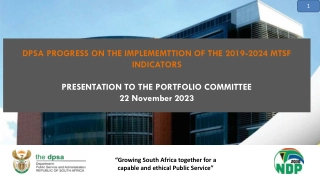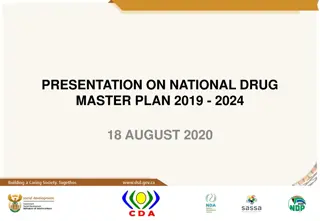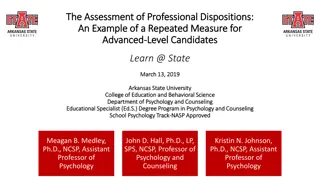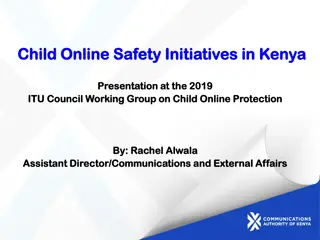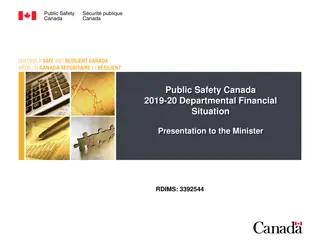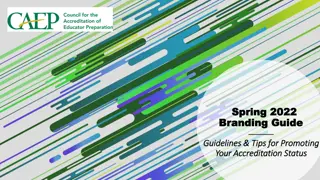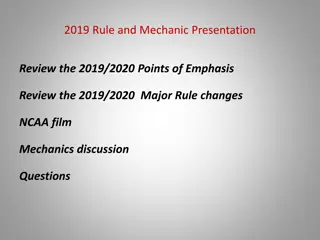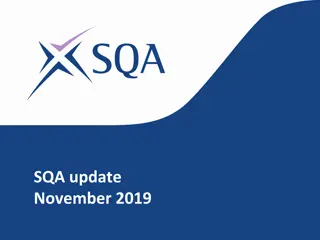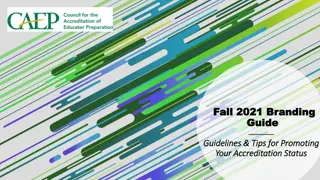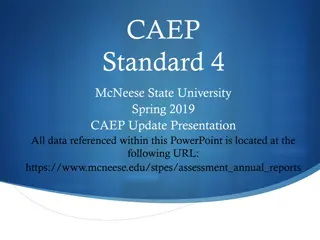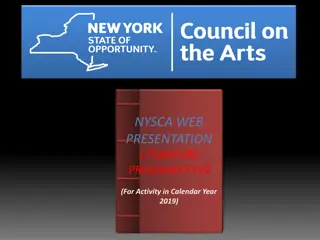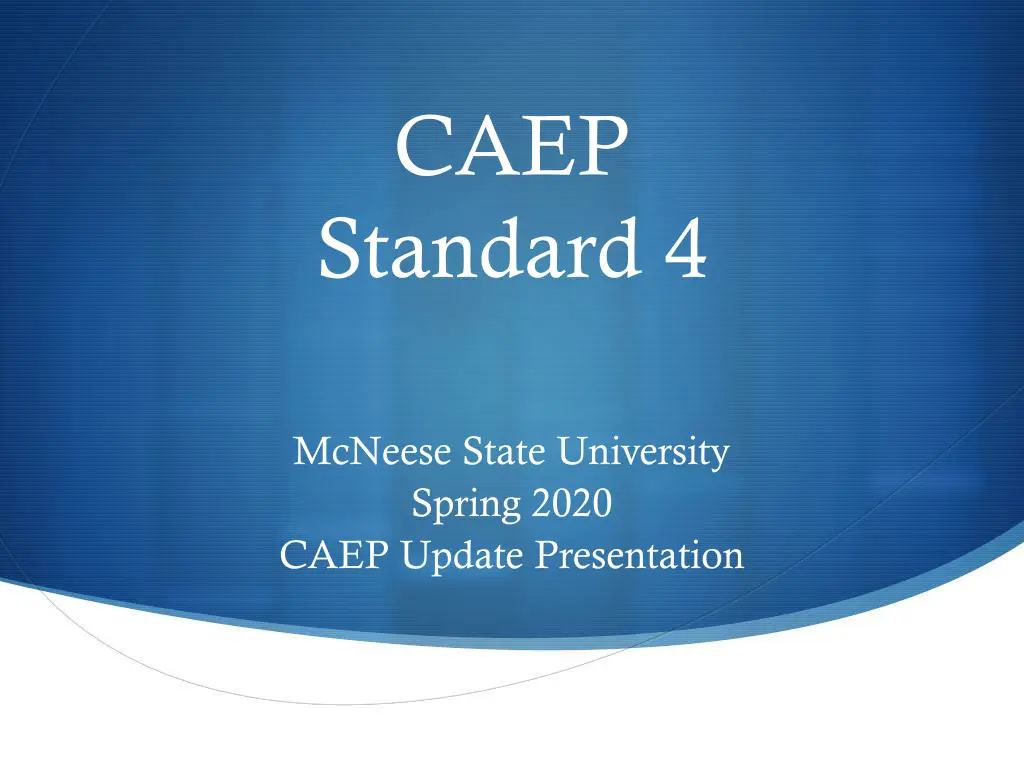
Demonstration of Impact: CAEP Standard 4 and Louisiana DOE Expectations
Learn about how education providers demonstrate impact on student learning, graduation rates, and teacher effectiveness as per CAEP Standard 4. Explore the expectations set by the Louisiana Department of Education for effective teaching programs. Discover key metrics and reporting measures to assess program outcomes.
Download Presentation

Please find below an Image/Link to download the presentation.
The content on the website is provided AS IS for your information and personal use only. It may not be sold, licensed, or shared on other websites without obtaining consent from the author. If you encounter any issues during the download, it is possible that the publisher has removed the file from their server.
You are allowed to download the files provided on this website for personal or commercial use, subject to the condition that they are used lawfully. All files are the property of their respective owners.
The content on the website is provided AS IS for your information and personal use only. It may not be sold, licensed, or shared on other websites without obtaining consent from the author.
E N D
Presentation Transcript
CAEP Standard 4 McNeese State University Spring 2020 CAEP Update Presentation
InTASC Standards The Learner and Learning Standard 1- Learner Development Standard 2- Learning Differences Standard 3- Learning Environments Content Knowledge Standard 4- Content Knowledge Standard 5- Application of Content Instructional Practice Standard 6- Assessment Standard 7- Planning for Instruction Standard 8- Instructional Strategies Professional Responsibility Standard 9- Professional Learning and Ethical Practice Standard 10- Leadership and Collaboration
Standard 4 The provider demonstrates the impact of its completers on P-12 student learning and development, classroom instruction, and schools, and the satisfaction of its completers with the relevance and effectiveness of their preparation.
8 Annual Reporting Measure Program Outcome and Consumer Information: Completer or graduation rates Licensure rate Employment rate Consumer information, including students loan default rate Program Impact: P-12 student learning/ development Observations of teaching effectiveness Employer satisfaction Completer persistence
Louisiana Department of Education Expectations Highly Effective: 4.0-3.5 Effective: Proficient: 3.49-2.5 Effective: Emerging: 2.49-1.5 Ineffective: 1.49-1.0
Impact of P-12 learning and development (CAEP 4.1) Louisiana Board of Regents statement: "Due to discrepancies found in data used to calculate Growth in Student Learning Scores and Compass Teacher Evaluation Scores for new teachers completing individual teacher preparation programs, it was not possible to release 2019 Teacher Preparation Data Dashboards or create a 2019 Teacher Preparation Fact Book. Please go to the USDE Title 2 website at https://Title2.ed.gov to locate information about teacher preparation programs pertaining to: listing of programs, number of enrolled candidates, race and gender of enrolled candidates, number of completers, GPA of completers, Praxis passage rates, and other relevant information.
Indicators of teaching effectiveness (CAEP 4.2) Louisiana Board of Regents statement: "Due to discrepancies found in data used to calculate Growth in Student Learning Scores and Compass Teacher Evaluation Scores for new teachers completing individual teacher preparation programs, it was not possible to release 2019 Teacher Preparation Data Dashboards or create a 2019 Teacher Preparation Fact Book. Please go to the USDE Title 2 website at https://Title2.ed.gov to locate information about teacher preparation programs pertaining to: listing of programs, number of enrolled candidates, race and gender of enrolled candidates, number of completers, GPA of completers, Praxis passage rates, and other relevant information.
2018 Louisiana Fact Book and Data Dash Boards: Undergraduate Year Mean Number Ineffective Effective: Emerging Effective: Proficient Highly Effective Compass Student Growth (SLT/VAM) (CAEP 4.1) 3% 7% 1% 10% 1% 10% 2016 2017 2018 3.4 (n=446) 3.4 (n=422) 3.4 (n=360) 28% 23% 19% 63% 66% 70% Compass Professional Practice (Observation Evaluations) (CAEP 4.2) 3.2 (n=446) 1% 2016 8% 62% 30% 2017 2018 3.2 (n=422) 3.3 (n=360) 1% 1% 7% 6% 55% 48% 37% 45% Compass Final Evaluation (Average of two categories) 3% 6% 2% 7% 1% 7% 2016 2017 2018 3.3 (n=446) 3.4 (n=422) 3.4 (n=360) 51% 45% 38% 41% 46% 54%
2018 Louisiana Fact Book and Data Dash Boards: Master of Arts in Teaching (MAT) Year Mean Number Ineffective Effective: Emerging Effective: Proficient Highly Effective Compass Student Growth (SLT/VAM) (CAEP 4.1) 3% 6% 1% 6% 1% 8% 2016 2017 2018 3.4 (n=179) 3.5 (n=120) 3.6 (n=78) 27% 22% 15% 64% 72% 76% Compass Professional Practice (Observation Evaluations) (CAEP 4.2) 3.3 (n=179) 0% 2016 7% 51% 42% 2017 3.2 (n=120) 0% 8% 44% 48% 2018 3.4 (n=78) 0% 6% 37% 56% Compass Final Evaluation (Average of two categories) 3% 3% 2016 3.4 (n=179) 49% 45% 2017 3.5 (n=120) 1% 3% 43% 53% 2018 3.6 (n=78) 1% 3% 35% 62%
2018 Louisiana Fact Book and Data Dash Boards: Alternative Certification (PBC) Year Mean Number Ineffective Effective: Emerging Effective: Proficient Highly Effective Compass Student Growth (SLT/VAM) (CAEP 4.1) 1% 10% 2016 3.4 (n=105) 26% 64% 2017 2018 3.5 (n=84) 3.6 (n=80) 0% 0% 6% 4% 29% 25% 66% 71% Compass Professional Practice (Observation Evaluations) (CAEP 4.2) 3.3 (n=105) 0% 2016 6% 50% 45% 2017 2018 3.3 (n=84) 3.4 (n=80) 0% 0% 4% 3% 49% 45% 48% 53% Compass Final Evaluation (Average of two categories) 1% 5% 0% 5% 2016 2017 3.4 (n=105) 3.5 (n=84) 45% 42% 50% 54% 2018 3.6 (n=80) 0% 3% 38% 60%
Program Comparison 2018 Factbook and Data Dashboard Compass Final Evaluation (combined CAEP 4.1 and 4.2) Program Mean number 3.4 (n=360) 3.6 (n=78) 3.6 (n=80) Ineffective Effective: Emerging 7% Effective: Proficient 38% Highly Effective 54% Undergraduate 1% MAT 1% 3% 35% 62% PBC 0% 3% 38% 60%
Completer Data Conclusions from 2018 (combined CAEP 4.1 and 4.2) Undergraduate, MAT, and PBC completers teaching in their first or second year in the 2015-2016 academic year had mean scores of Effective Proficient to Highly Effective (m=3.4-3.6) in all three categories of Student Growth, Professional Practice, and Final Evaluations. When combining all 4.1 and 4.2 data found within the LBoR Factbook and Data Dashboards and then comparing all three initial-certification program types, the PBC program has the highest percentage of completers scoring at the Effective: Proficient and Highly Effective range at 97%, followed by MAT program at 96%, and undergraduate program at 92%.
Program Comparison 2018 Factbook and Data Dashboard Compass Student Growth (SLT/VAM) CAEP 4.1 Program Mean number 3.4 (n=360) 3.6 (n=78) 3.6 (n=80) Ineffective Effective: Emerging 10% Effective: Proficient 19% Highly Effective 70% Undergraduate 1% MAT 1% 8% 15% 76% PBC 0% 4% 25% 71%
Student Growth (VAM) Disaggregation by Content Area: Undergraduate Year number Ineffective Effective: Emerging Effective: Proficient Highly Effective Math 2016 37 41% 35% 19% 5% 2017 11 64% 18% 0% 18% 2018 14 50% 29% 7% 14% Science 2016 27 15% 48% 33% 4% 2017 19 21% 21% 47% 11% 2018 17 12% 47% 29% 12% Social Studies 2016 35 9% 51% 29% 11% 2017 -- -- -- -- -- 2018 -- -- -- -- -- English Language Arts 2016 45 27% 42% 27% 4% 2017 11 21% 26% 32% 21% 2018 22 18% 32% 32% 18%
Student Growth (VAM) Disaggregation by Content Area: Master of Arts in Teaching (MAT) Year number Ineffective Effective: Emerging Effective: Proficient Highly Effective Math 2016 34 12% 53% 21% 15% 2017 -- -- -- -- -- 2018 -- -- -- -- -- Science 2016 2017 29 12 14% 0% 59% 75% 14% 0% 14% 25% 2018 10 10% 80% 0% 10% English Language Arts 43% 2016 28 21% 25% 11% 2017 -- -- -- -- -- 2018 11 0% 46% 36% 18%
Student Growth (VAM) Disaggregation by Content Area: Alternative Certification (PBC) Year number Ineffective Effective: Emerging English Language Arts 36% Effective: Proficient Highly Effective 2016 25 28% 24% 12% 2017 -- -- -- -- -- 2018 10 30% 50% 10% 10%
P-12 Learning and Development Conclusions from 2018 (CAEP 4.1) Undergraduate, MAT, and PBC completers teaching in their first or second year in 2015-2016 academic year had mean scores of Effective Proficient to Highly Effective (m=3.4-3.6) in Student Growth when SLTs and VAM scores are combined. Disaggregated VAM scores by grade level and content area for undergraduate completers, indicate math as an area of challenge. ELA in undergraduate and MAT has our highest scoring content area percentages ranked at 3rd and 4th, respectively, in the state.
P-12 Learning and Development Next Steps (CAEP 4.1) Teaching Cycle in all methods courses Assessment course redesign Deans for Impact Collaborative implementation of four- semester math content and methods redesign Addition of Tier 1 curriculum Domain 5 aligning to Louisiana Preparation Teacher Competencies
Program Comparison 2018 Factbook and Data Dashboard Compass Professional Practice (Observation Evaluations; CAEP 4.2) Program Mean number 3.3 (n=360) 3.3 (n=78) 3.7 (n=80) Ineffective Effective: Emerging 6% Effective: Proficient 48% Highly Effective 45% Undergraduate 1% MAT 0% 6% 37% 56% PBC 0% 3% 45% 53%
Observations of Teaching Effectiveness Conclusions from 2018 (CAEP 4.2) Data across the three programs (undergraduate, MAT, and PBC) indicate that completers are consistently scored within the Emerging Proficient (2.5-3.49) and Highly Effective (3.5-4.0) range when being evaluated by their administration.
Observations of Teaching Effectiveness Next Steps (CAEP 4.2) Move from Field Experience Evaluation instrument to Louisiana Department of Education Compass instrument. Norm the new instrument with university supervisors, faculty, and mentor teachers. Each year have stakeholders will complete inter-rater reliability training Mentor Teacher Training Implementation of the POP cycle (pre-observation; observation; post-observation) within methodology courses
Enrollment and Completer Numbers Undergraduate Year 2013-14 2014-15 2015-16 Enrolled 206 204 214 Completers 102 81 85 Total 308 285 299 Alternative Certification Year 2013-14 2014-15 2015-16 Enrolled 58 72 67 Completers 37 40 38 Total 95 112 105
Enrollment and Completer Numbers Next Steps EdRising initiative for traditional programs Addition of a Minor in Education Hubspot for supporting electronic recruiting efforts for alternative certification programs
Persistence Data Completers teaching in public schools in Louisiana Undergraduate Alternative Certification Completion Year 2013-14 2014-15 2015-16 Number Percentage after 5 years 72% (n=76) 69% (n=74) 69% (n=72) Completion Year 2013-14 2014-15 2015-16 Number Percentage after 5 years 70% (n=49) 69% (n=62) 66% (n=56) 105 108 104 70 90 85
Persistence Data Next Steps All redesigned initial-certification programs are now available US PREP Coalition Member with a site coordinator to support two-semester residency experience Inclusion of Tier 1 curriculum Inclusion of a Motivation and Engagement course along with Classroom Management Additional special education coursework Embedded texts for supporting social-emotional learning
MSU Created Survey: Employer Satisfaction (ESS) By the Numbers Undergraduate InTASC standards and cross-cutting themes (technology/diversity) had mean range scores of 3.75 and 3.61, respectively, scoring at the well-prepared level. Completers: 4% Overall return rates: Spring 2018 The lowest score earned by the undergraduate completers by their employers was a mean score of 3.5 for InTASC standard 2. Fall 2018 Completers: 26% PBC InTASC standards and cross-cutting themes (technology/diversity) had means range scores of 4.0, well- prepared level.
MSU Created Survey: Employer Satisfaction In their own words Two recommendations for this completers: Spring 2018 Completers: Classroom Environment and Management (40%) Curriculum Design and Implementation (20%) Student Assessment and Monitoring (13%) Quality of Instructional Practices (13%) Professional Dispositions (13%) Fall 2018 Completers: Student Assessment (50%) Curriculum Design and Implementation (25%) Classroom Environment and Management (25%)
Quotes from 2018 Employer Satisfaction Surveys Demonstrates a high level of creativity for motivating her students (ECHD PBC) Very resourceful and shows willingness to incorporate more strategies as she progresses (ELEM BS) I have no recommendations for this candidate at this time. I just did her first Compass observation and I was very pleased with her performance (ECHD BS) Her strength is in communicating with her English team in order to better her practices in the classroom (ENGL BA)
Employer Satisfaction Survey Conclusions InTASC standards 1-10 show candidates scored at sufficiently prepared for both semesters and undergraduate and alternative certification programs with mean scores of 3.5-4.0. Secondary English (n=1) showed consistent scoring at the not sufficiently prepared level for multiple InTASC standards. For both Spring and Fall 2018, employers listed Curriculum Design and Implementation in the top two recommendations at 20% and 25%, respectively
Employer Satisfaction Next Steps The assessment course has been rewritten and aligned with the Senior Year Residency Performance Portfolio. The Teaching Cycle which includes analysis of student summative data and student work samples is required for all methods courses. A curriculum design/lesson planning course has been added to all initial certification programs Repeatedly low participation has led the EPP to partner with Skyfactor to support creating and sending a survey using more modern technology applications. The EPP hopes that this will engage more participants and will also help with data collection and analysis of findings.
MSU Created Survey: Completer Follow-up (CFS) By the Numbers Undergraduate and PBC InTASC standards 1-10 had range scores of 3.0-4.0 for both semesters meaning all completers (n=10) scored at sufficiently prepared or well prepared . The lowest mean score of 2.5 was noted for the Social Studies undergraduate program (n=2) for InTASC Standard 1. Overall return rates: Spring 2018 completers: 9% Fall 2018 Completers: 22%
MSU Created Survey: Completer Follow-up In their own words What are your toughest transitions from college to the classroom? Spring 2018 Completers: Classroom Environment and Management (44%) Professional Dispositions (33%) Curriculum and Design and Implementation (22%) Fall 2018 Completers: Classroom Environment and Management (44%) Curriculum Design and Implementation (17%) Student Assessment and Monitoring (17%) Professional Dispositions (17%) Quality of Instructional Practices (6%)
Quotes from 2018 Completer Follow-up Surveys Classroom management has been something I have been struggling with, but I don't think it was because I was not sufficiently prepared. I came in during the middle of the school year after several other subs had already been filtering through before me as well. I think all of this contributes some of the chaos that happens in my classroom and why the students are harder to manage. (BS Business) I believe most of a teacher candidate experience comes from within the classroom. I have learned majority of my knowledge, techniques, management, etc from being in the classroom and working with both students and colleagues. Seeing how a classroom functions and is managed helped me to become a better teacher. Being able to observe and monitor in different schools and classrooms, I was able to see different levels of learning and how to monitor different assessments. (BS Early Childhood)
Completer Follow-up Survey Conclusions and Next Steps CFS data indicates no trends can be established as each survey iteration shows strengths and challenges within the individual programs offered by the EPP (undergraduate, MAT, PBC). Repeatedly low participation has led the EPP to partner with Skyfactor to support creating and sending a survey using more modern technology applications. The EPP hopes that this will engage more participants and will also help with data collection and analysis of findings.
Employer Satisfaction Survey and Completer Follow-up Survey Comparison InTASC Completer Follow-up 3.56 3.82 Employer Satisfaction 3.68 4.0 Difference Baccalaureate Alternative Certification .12 .18 Combined results for both CFS and ESS administered for spring and fall 2018 indicated that employers rated completer abilities higher than our graduates by .12 for baccalaureate program completers and .18 for alternative certification program completers.
MSU Institutional Research Office Graduation/Matriculation Rates
Graduation/Matriculation Rates Initial-certification Programs Next Steps During summer 2019, all PBC and MAT coursework will be redesigned to become online programs. Many of our candidates are working as classroom teachers and travel from long distances to attend face-to-face classes. This should alleviate the time constraints of working a full-time job and attending night classes several times a week. We have added pre-selected videos as part of the field experience requirements that are aligned to course assignments and standards to support candidates having less time away from their full-time teaching assignments. We have also added Praxis workshops, created by faculty who are experts in the content. This extra support is for those candidates that cannot progress in the program without passage of Praxis I or II.
Teach Louisiana: Licensure and Employment Rates (Initial Certification Programs) Undergraduate Year Number of graduates Percentage that began teaching year immediately 82% (n=66) 79% (n=67) 56% (n=49) Percentage that was granted state license 99% (n=80) 97% (n=82) 97% (n=84) 2014-15 2015-16 2016-17 81 85 87 Alternative Certification Year Number of graduates Percentage that began teaching year immediately 78% (n=31) 76% (n=29) 82% (n=32) Percentage that was granted state license 100% 97% (n=37) 97% (n=38) 2014-15 2015-16 2016-17 40 38 39
Teach Louisiana: Graduation and Licensure Rates Advanced Programs
Graduation and Licensure Rates Advanced Programs Next Steps Newly redesigned Master of Education in Curriculum and Instructions programs in place for 2020-2021 Continue the Mentor Teacher Training pathways for 2020-2021: Professional Development Embedded in the Master of Education programs
United States Department of Education: MSU Loan Default Rates Fiscal Year 2016 2015 2014 2013 Default rate 13.6% 9.9% 11% 12.4% # in default 227 178 195 224 # in repayment 1.662 1,795 1,758 1,805 National cohort default rate 10.1% 10.8%
Questions?? Contact Dr. Angel Ogea, Dean of the Burton College of Education aogea@mcneese.edu

